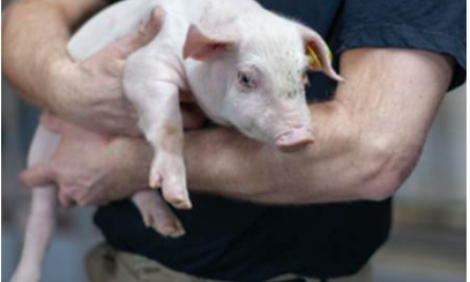



Researchers Investigate Immune Responses to Respiratory Viruses
PRRS virus-induced immunosuppression exacerbates the inflammatory response to porcine respiratory coronavirus in pigs, according to new research from the state universities of Ohio and South Dakota.Gourapura J. Renukaradhya of Ohio State University and co-authors there and at South Dakota State University have published their studies into the interrelationship between porcine reproductive and respiratory syndrome (PRRS) virus and porcine respiratory coronavirus. Their paper was published in Viral Immunology last year.
The researchers explain that they performed a comprehensive analysis of innate and adaptive immune responses in dual-virus infected pigs to understand whether a pre-existing immunomodulatory respiratory viral infection affects the overall immunity to a subsequent porcine respiratory coronavirus (PRCV) infection in pigs.
Pigs were either mock-infected or infected with PRRS virus (PRRSV), a virus known to cause immunosuppressive respiratory disease, and then pigs were co-infected with PRCV, which normally causes subclinical respiratory infection.
They collected samples for six independent experiments from 178 pigs that were also used for pathological studies.
Renukaradhya and co-authors detected a significant reduction in innate NK-cell-mediated cytotoxic function in PRRSV-infected pigs, which was synergistically further decreased in pigs co-infected with PRCV. Subsequently, in association with clinical signs they observed elevated levels of pro-inflammatory (IL-6), Th-1 (IL-12), and regulatory (IL-10 and TGF-β) cytokines. Increased frequencies of CD4CD8 double-positive T lymphocytes and myeloid cells, in addition to the elevated Th-1 and pro-inflammatory cytokines in dual-infected pigs, contributed to the severity of lung disease in pigs.
The scientists conclude that the results of their study clarify how each virus modulates the host innate and adaptive immune responses, leading to inflammatory reactions and lung pathology. Thus, measurements of cytokines and frequencies of immune cells may serve as indicators of the progression of respiratory viral co-infections, and provide more definitive approaches for treatment, added Renukaradhya and co-authors.
Reference
Renukaradhya G.J., K. Alekseev, K. Jung, Y. Fang and L.J. Saif. 2010. Porcine reproductive and respiratory syndrome virus–induced immunosuppression exacerbates the inflammatory response to porcine respiratory coronavirus in pigs. Viral Immunology. October 2010, 23(5): 457-466. doi:10.1089/vim.2010.0051.
Further Reading
| - | You can view the full report (fee payable) by clicking here. |
Further Reading
| - | Find out more information on porcine reproductive respiratory syndrome (PRRS) by clicking here. |
January 2011








